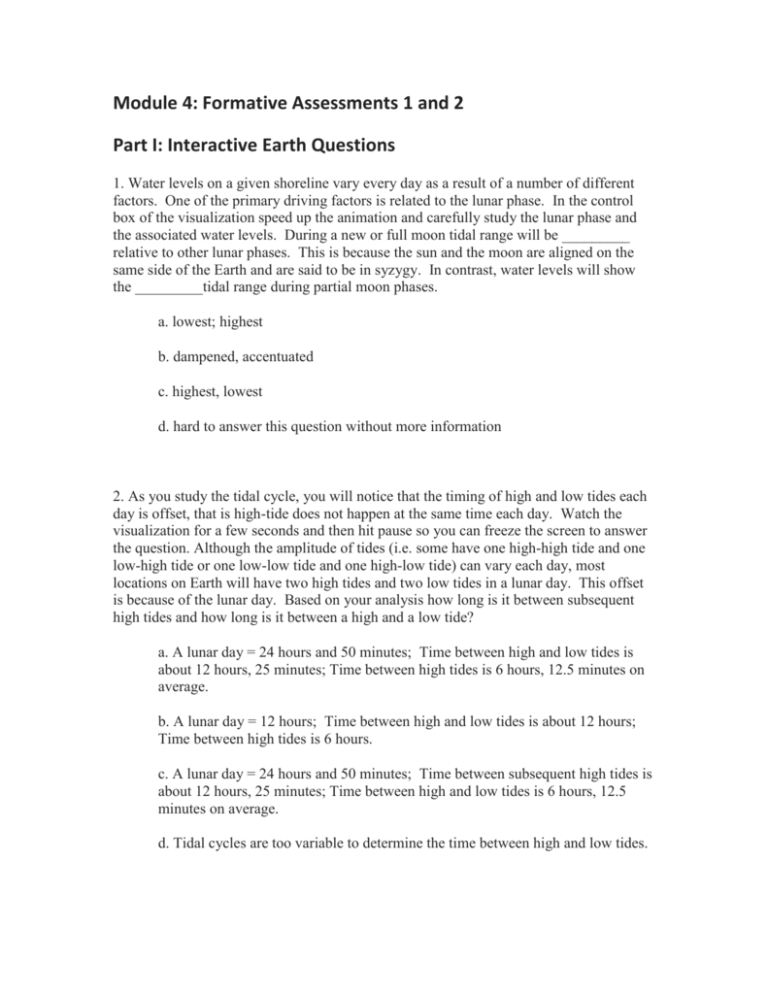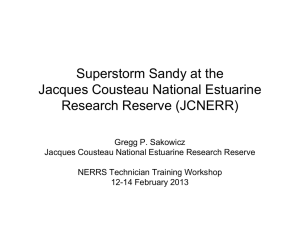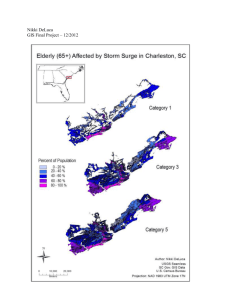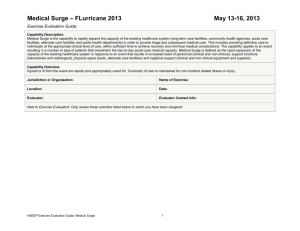this Worksheet - e
advertisement

Module 4: Formative Assessments 1 and 2 Part I: Interactive Earth Questions 1. Water levels on a given shoreline vary every day as a result of a number of different factors. One of the primary driving factors is related to the lunar phase. In the control box of the visualization speed up the animation and carefully study the lunar phase and the associated water levels. During a new or full moon tidal range will be _________ relative to other lunar phases. This is because the sun and the moon are aligned on the same side of the Earth and are said to be in syzygy. In contrast, water levels will show the _________tidal range during partial moon phases. a. lowest; highest b. dampened, accentuated c. highest, lowest d. hard to answer this question without more information 2. As you study the tidal cycle, you will notice that the timing of high and low tides each day is offset, that is high-tide does not happen at the same time each day. Watch the visualization for a few seconds and then hit pause so you can freeze the screen to answer the question. Although the amplitude of tides (i.e. some have one high-high tide and one low-high tide or one low-low tide and one high-low tide) can vary each day, most locations on Earth will have two high tides and two low tides in a lunar day. This offset is because of the lunar day. Based on your analysis how long is it between subsequent high tides and how long is it between a high and a low tide? a. A lunar day = 24 hours and 50 minutes; Time between high and low tides is about 12 hours, 25 minutes; Time between high tides is 6 hours, 12.5 minutes on average. b. A lunar day = 12 hours; Time between high and low tides is about 12 hours; Time between high tides is 6 hours. c. A lunar day = 24 hours and 50 minutes; Time between subsequent high tides is about 12 hours, 25 minutes; Time between high and low tides is 6 hours, 12.5 minutes on average. d. Tidal cycles are too variable to determine the time between high and low tides. 3. Go back to the model and add a storm event to the mix to see how sea-levels change relative to the normal tidal cycle. To do this, add a storm with a one day duration and with a surge height that is equal to your normal tidal range, let the model run to see what happens and hit pause after the tides return to normal. Do this for several lunar phases (full moon, quarter moon). Given this model, rank the following scenarios according to worst case scenarios for potential for damage on the shoreline to the best case scenario. (Most Damage) Worst Case: ______ Damage) ______ ______ ______ Best Case (Least Scenario 1: storm surge hits during full moon at low tide Scenario 2: storm surge hits during quarter moon at high tide Scenario 3: storm surge hits during full moon at high tide Scenario 4: storm surge hits during quarter moon at low tide Now what about long-term sea-level rise impacts? In the model you can add a long-term sea-level rise factor to see what happens. By speeding up the visualization it is possible to see that more and more of the coast line will be inundated to the point that low tides in the future will be higher than high tides today. Making any more specific observations in this module is difficult so to better visualize the scenarios associated with long-term sealevel rise, we will look at the other visualization models. Part 2: Sea-Level Rise Visualization for Alabama, Mississippi, and Florida Tool 4. For our first question, we will focus on the impact of Katrina's high water on Biloxi, Mississippi. Biloxi, Gulf Shores and Pass Christian suffered extensively from the high water levels from Katrina's storm surge. Refer to the Google Earth kmz file to help you locate specific items of interest in order to answer the questions. You will want to turn on historical imagery and compare today's aerial imagery with imagery from 7/2005 (just before Katrina) to 8/2005 or 9/2005 just after Katrina. East Biloxi is known for its casinos, one casino in particular was built on a large floating barge attached to a large shoreline pier complex. As a result of Katrina's storm surge it broke loose and was pushed inland. How far was this large barge moved? Use the measure distance tool in Google Earth and select the best answer below. a. The casino barge was pushed inland to the southeast a distance of just under 100 meters. b. The casino barge was pushed inland to the northwest a distance of 200 meters. c. The casino barge was pushed inland to the northwest a distance of more than 500 meters. d. The casino barge was pushed inland to the southeast a distance of about 400 meters. 5. Find the location of the casino in the USGS SLR Viewer tool. Use the search tool in the upper left corner of the map window to easily zoom to Biloxi. The barge came to rest between Meaut Street and US-90 (East Beach Blvd) just a few 10's of meters east of Kuhn Street. During Katrina's maximum surge, what was the surge water depth where the casino came to rest? Use the viewer and right click on the location to determine water depths at the southeast corner of the casino barge. a. surge depth = `5' b. surge depth = `10' c. surge depth = `20' d. surge depth = >25' 6. Sound side flooding in the Back Bay of Biloxi was also significant, including in the area near Kessler Air Force Base and Interstate 110 (MS-15 South). Flood surge levels on Division Street where it runs underneath I-110 was________ feet deep at a distance some 1.2 km to the south of Back Bay Blvd. In fact, surge waters on this side of the barrier island extended in a line about 1.6 km back from the sound-side shoreline. a. surge depth = `5 b. surge depth = `10' c. surge depth = `20' d. surge depth = >25' 7. Turn on the Terrain Background Layer. Given that an area that runs east to west or (slightly southeast to slightly northwest) in the vicinity of Esposito Street and Howard Avenue didn't go under water, even though areas to the north and south of this linear feature did, why do you think surge didn't hit this area? a. This linear feature is probably a former beach ridge and represent the highest natural elevation on the barrier. b. This linear feature is bound by a series of protective structures designed to prevent flooding. c. Storm surge was so severe and had picked up so much debris that it formed a dam that the waves and water couldn't penetrate. d. None of these adequately explains why the surge didn't hit this area. 8. Turn on the 2010 Census Block Population data layer and notice that there are two census blocks with fairly high population densities east of the I-110 Corridor. Both of these residential areas contain upwards of a 1000 people per block. When you zoom in (Using Google Earth or other) you will notice that most of the homes in these areas are single story homes. During Katrina, these areas were flooded by between ______ and ______feet of water. a. 0 and 4 feet of water b. 6 and 15 feet of water c. 15 and 25 feet of water d. more than 25 feet of water 9. Now let's shift gears just a little bit and look at a shore parallel transect going from east to west. Pass Christian, Mississippi saw some of the worst storm surge levels of all of the northern Gulf Coast cities, while cities to the east saw progressively lower and lower water levels. If you explore and left click (to find the water depth as you did before) on the map view window you will find an interesting pattern. In the area of Gulf Shores and Dauphin Island Alabama near the mouth of Mobile Bay, Katrina's surge levels produced some overwash and extensive shoreline erosion, but generally had surge levels of less than 5 feet along the upper beach face. Overwash extended a minimal distance inland and only a few blocks of homes were impacted by the high water. As we noted previously, water levels approached 20 or more feet further to the west. Chose the answer below that might best explain these observations. a. Southern Alabama was located in the northeast quadrant of the storm when it came ashore. This means its wind field and therefore surge were the lowest of the entire coast even though the Mississippi-Alabama Shelf is at its widest point here. b. Pass Christian had absolutely no shoreline defense (natural or man-made). This undoubtedly contributed to the higher water levels observed there. c. Shoreline development in Alabama was minimal relative to shoreline development in Mississippi. This helped to prevent the high storm surge levels. d. Southern Mississippi (Pass Christian to Biloxi) experienced very high flooding because storm surge was funneled westward along shore behind the offshore barrier islands through the narrow Biloxi Bay toward Lake Borgne and Lake Pontchartrain building high water levels. 10. Although water levels from Katrina's storm surge were significant for a just a few hours, it certainly was devastating for the entire Gulf Coast and weighs in as one of the most costly natural hazards in U.S. history. That said some scientists believe that the risk of future sea-level rise, based on historical records, suggests that these hard-hit regions will see even more destruction in the future. Although storm surge was most pronounced on the coast, flooding extended up coastal river systems, including Biloxi River and Tchoutacabouffa River just north of the Back Bay of Biloxi. People often think the impact was limited to the coast. Is this true? Using the USGS SLR visualization tool together with Google Earth, determine how far inland a SLR of 3' would reach on the Biloxi River? a. A 3' SLR would extend northwestward to about the position of Three Rivers Road just west of US Rte 605 (Dallas Street) a distance some 7 to 8 km from Coley Island. b. A 3' SLR would extend northwestward to about the position of the mouth of Little Biloxi River near the Grand Bear Golf Course some 9 to 10 km from Coley Island. c. A 3' SLR would extend northwestward to a position north of the Grand Bear Golf Course some 11 to 12 km from Coley Island. d. A 3' SLR would extend northwestward to a position just east of U.S. 49 and Grandway Blvd. on the western edge of DeSoto National Forest a distance some 18 to 19 km inland. This was also about the inland extent of Katrina's storm surge. 11. Given that Katrina's storm surge extended inland by as much as 18 to 19 km, a sustained sea-level inundation due to SLR would have a major negative impact on all but which of the following? a. Significant tracks of productive salt marsh and coastal bayou habitats, which act as nurseries to many important species, would be flooded. b. Freshwater river systems and tidal estuaries would be pushed further upstream. c. Coastal groundwater aquifers would experience salt water intrusion as a result of sea-level . d. Navigable waterways would be severely impaired due to changes in sedimentation. 12. One question you should begin to think about is: how fast does sea-level change? If SLR becomes a reality, how much time do coastal communities like Biloxi really have before significant decisions have to be made? Based on what you have been learning through the previous questions and your explorations of the USGS SLR visualization, which SLR scenario do you consider is a point of no return? In other words under which SLR condition would you expect that large-scale changes MUST be made to protect either the current infrastructure or a decision needs to be made to relocate infrastructure to a new and safe location? There is no right or wrong answer, as long as you have a justification for your answer. Perhaps you will want to share your thoughts in the weekly blog as you think about what you have been learning. a. Decisions are past-due; should have been made after Katrina. b. Decisions should be made before we experience a 1' SLR, but we have to make a decision in the next decade or two. c. Decisions should be made before we experience a 2' SLR, but we have a few decades before we have to make a decision. d. Decisions should be made before we experience a 3' SLR, but we have at least a century before we have to make this decision. e. Decisions should be made before we exceed a 3' SLR or more, so we have more than enough time to come up with a plan of action.





